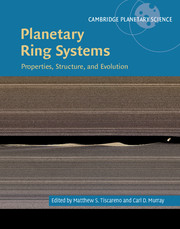Book contents
- Frontmatter
- Contents
- List of Contributors
- Acknowledgements
- I Introductory Material
- II Ring Systems by Location
- III Ring Systems by Type and Topic
- 8 Moonlets in Dense Planetary Rings
- 9 Meteoroid Bombardment and Ballistic Transport in Planetary Rings
- 10 Theory of Narrow Rings and Sharp Edges
- 11 Narrow Rings, Gaps, and Sharp Edges
- 12 Dusty Rings
- 13 The F Ring of Saturn
- 14 Plasma, Neutral Atmosphere, and Energetic Radiation Environments of Planetary Rings
- 15 Thermal Properties of Rings and Ring Particles
- 16 Computer Simulations of Planetary Rings
- 17 Laboratory Studies of Planetary Ring Systems
- 18 The Origin of Planetary Ring Systems
- IV Concluding Material
- Index
- Plate section
- References
11 - Narrow Rings, Gaps, and Sharp Edges
from III - Ring Systems by Type and Topic
Published online by Cambridge University Press: 26 February 2018
- Frontmatter
- Contents
- List of Contributors
- Acknowledgements
- I Introductory Material
- II Ring Systems by Location
- III Ring Systems by Type and Topic
- 8 Moonlets in Dense Planetary Rings
- 9 Meteoroid Bombardment and Ballistic Transport in Planetary Rings
- 10 Theory of Narrow Rings and Sharp Edges
- 11 Narrow Rings, Gaps, and Sharp Edges
- 12 Dusty Rings
- 13 The F Ring of Saturn
- 14 Plasma, Neutral Atmosphere, and Energetic Radiation Environments of Planetary Rings
- 15 Thermal Properties of Rings and Ring Particles
- 16 Computer Simulations of Planetary Rings
- 17 Laboratory Studies of Planetary Ring Systems
- 18 The Origin of Planetary Ring Systems
- IV Concluding Material
- Index
- Plate section
- References
Summary
INTRODUCTION
Although Saturn's broad A, B, and C rings epitomize the concept of “planetary rings” in the minds of most people, much of our detailed knowledge of ring dynamics has come from the investigation of smaller-scale features such as density and bending waves, the numerous narrow gaps and their embedded ringlets, and the sharp edges which often demarcate various ring regions. In the case of Uranus, almost all of the ring mass is in the form of narrow rings. Narrow ringlets and gaps, and their associated sharp edges (including those of broad rings) form the subject of this chapter, along with the dynamical theories their study has spawned and the puzzles that continue to surround them.
Examples of several narrow gaps and ringlets in Saturn's rings, as well as the very prominent sharp outer edge of the B ring, are shown in Figure 11.1, from French et al. (2016b). Here one can see a total of eight narrow gaps in the region known as the Cassini Division, ranging in width from 5 km to 360 km, as well as four narrow ringlets. At least six more narrow gaps are found in the outer A ring and in the C ring, while three additional narrow ringlets occur in the C ring. The present chapter will cover all of these features, as well as the ten narrow Uranian rings. Recently a pair of narrow, dense rings has been discovered around the centaur object, Chariklo (Braga-Ribas et al., 2014). These are discussed separately in Chapter 7. We also do not discuss the more tenuous and dusty Jovian and Neptunian ring systems, nor the dusty ringlets found at Saturn and Uranus, all of which are covered in Chapter 12. The complex and unique F ring is described in Chapter 13.
We begin with a short overview of the relevant observations and their limitations in Section 11.2, before reviewing the kinematics, systematic width variations and internal structure of narrow ringlets in Section 11.3. In Section 11.4 we discuss the gaps in Saturn's rings, including searches for any embedded satellites. Section 11.5 deals with individual ringlet and gap edges, especially those that are controlled by resonances with external satellites and those that show evidence for local perturbations by unseen, embedded objects.
- Type
- Chapter
- Information
- Planetary Ring SystemsProperties, Structure, and Evolution, pp. 276 - 307Publisher: Cambridge University PressPrint publication year: 2018
References
- 6
- Cited by

